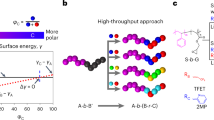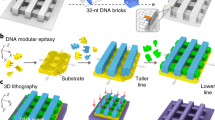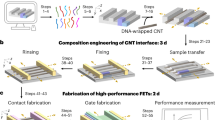Abstract
The drive to deliver increasingly powerful and feature-rich integrated circuits has made technology node scaling—the process of reducing transistor dimensions and increasing their density in microchips—a key challenge in the microelectronics industry. Historically, advances in optical lithography patterning have played a central role in allowing this trend to continue. Directed self-assembly of block copolymers is a promising alternative patterning technique that offers sub-lithographic resolution and reduced process complexity. However, the feasibility of applying this approach to the fabrication of critical device layers in future technology nodes has never been verified. Here we compare the use of directed self-assembly and conventional patterning methods in the fabrication of 7 nanometre node FinFETs, using an industrially relevant and high-volume manufacturing-compliant test vehicle. Electrical validation shows comparable device performance, suggesting that directed self-assembly could offer a simplified patterning technique for future semiconductor technology.
This is a preview of subscription content, access via your institution
Access options
Access Nature and 54 other Nature Portfolio journals
Get Nature+, our best-value online-access subscription
$29.99 / 30 days
cancel any time
Subscribe to this journal
Receive 12 digital issues and online access to articles
$119.00 per year
only $9.92 per issue
Buy this article
- Purchase on Springer Link
- Instant access to full article PDF
Prices may be subject to local taxes which are calculated during checkout





Similar content being viewed by others
Data availability
The data that support the plots within this paper and other findings of this study are available from the corresponding author upon reasonable request.
References
Park, M., Harrison, C., Chaikin, P. M., Register, R. A. & Adamson, D. H. Block copolymer lithography: periodic arrays of~1011 holes in 1 square centimeter. Science 276, 1401–1404 (1997).
Black, C. T. et al. Polymer self assembly in semiconductor microelectronics. IBM J. Res. Dev. 51, 605–633 (2007).
Thurn-Albrecht, T. et al. Ultrahigh-density nanowire arrays grown in self-assembled diblock copolymer templates. Science 290, 2126–2129 (2000).
Segalman, R. A., Yokoyama, H. & Kramer, E. J. Graphoepitaxy of spherical domain block copolymer films. Adv. Mater. 13, 1152–1155 (2001).
Bita, I. et al. Graphoepitaxy of self-assembled block copolymers on two-dimensional periodic patterned templates. Science 321, 939–943 (2008).
Kim, S. O. et al. Epitaxial self-assembly of block copolymers on lithographically defined nanopatterned substrates. Nature 424, 411–414 (2003).
Stoykovich, M. P. et al. Directed assembly of block copolymer blends into nonregular device-oriented structures. Science 308, 1442–1446 (2005).
Albrecht, T. R. et al. Bit-patterned magnetic recording: Theory, media fabrication, and recording performance. IEEE Trans. Magn. 51, 1–42 (2015).
Liu, C.-C. et al. DSA patterning options for logic and memory applications. Proc. SPIE 10146, 1014603 (2017).
Tsai, H. et al. Two-dimensional pattern formation using graphoepitaxy of PS-b-PMMA block copolymers for advanced FinFET device and circuit fabrication. ACS Nano 8, 5227–5232 (2014).
Black, C. et al. Integration of self-assembled diblock copolymers for semiconductor capacitor fabrication. Appl. Phys. Lett. 79, 409–411 (2001).
Ruiz, R. et al. Density multiplication and improved lithography by directed block copolymer assembly. Science 321, 936–939 (2008).
Hong, A. J. et al. Metal nanodot memory by self-assembled block copolymer lift-off. Nano. Lett. 10, 224–229 (2010).
Muramatsu, M. et al. Pattern defect reduction and LER improvement of chemo-epitaxy DSA process. Proc. SPIE 10144, 101440Q (2017).
Pathangi, H. et al. Defect mitigation and root cause studies in 14 nm half-pitch chemo-epitaxy directed self-assembly LiNe flow. J. Micro/Nanolith. MEMS MOEMS 14, 031204 (2015).
Azuma, T. et al. Electrical yield verification of half-pitch 15 nm patterns using directed self-assembly of polystyrene-block-poly (methyl methacrylate). J. Vac. Sci. Technol. B 33, 06F302 (2015).
Mitra, J., Torres, A. & Pan, D. Z. Process, design rule, and layout co-optimization for DSA based patterning of sub-10 nm FinFET devices. Proc. SPIE 10144, 101440G (2017).
Jacob, A. P. et al. Scaling challenges for advanced CMOS devices. Int. J. High Speed Electron. Syst. 26, 1740001 (2017).
Xie, R. et al. A 7 nm FinFET technology featuring EUV patterning and dual strained high mobility channels. In 2016 IEEE Int. Electron Devices Meet. (IEDM) 2.7.1–2.7.4 (IEEE, 2017)
Liu, C.-C. et al. Chemical patterns for directed self-assembly of lamellae-forming block copolymers with density multiplication of features. Macromolecules 46, 1415–1424 (2013).
Xu, P. et al. Sidewall spacer quadruple patterning for 15 nm half-pitch. Proc. SPIE 7973, 79731Q (2011).
Oyama, K. et al. Sustainability and applicability of spacer-related patterning towards 7 nm node. Proc. SPIE 9425, 942514 (2015).
Suh, H. S. et al. Sub-10-nm patterning via directed self-assembly of block copolymer films with a vapour-phase deposited topcoat. Nat. Nanotech. 12, 575–581 (2017).
Lane, A. P. et al. Directed self-assembly and pattern transfer of five nanometer block copolymer lamellae. ACS Nano 11, 7656–7665 (2017).
Wan, L. et al. The limits of lamellae-forming PS-b-PMMA block copolymers for lithography. ACS Nano 9, 7506–7514 (2015).
Pathangi, H. et al. Improved cost-effectiveness of the block co-polymer anneal process for DSA. Proc. SPIE 9777, 97771Z (2016).
Markoff, J. IBM discloses working version of a much higher-capacity chip. The New York Times (9 July 2015).
Ha, D. et al. Highly manufacturable 7nm FinFET technology featuring EUV lithography for low power and high performance applications. In 2017 Symp. VLSI Tech. (VLSIT) T68–T69 (IEEE, 2017).
Wu, S. et al. A 7 nm CMOS platform technology featuring 4th generation FinFET transistors with a 0.027μm 2 high density 6-T SRAM cell for mobile SoC applications. In 2016 IEEE Int. Electron Devices Meet. (IEDM) 2.6.1–2.6.4 (IEEE, 2016).
Auth, C. et al. A 10 nm high performance and low-power CMOS technology. In 2017 IEEE Int. Electron Devices Meet. (IEDM) 29.21.21–29.21.24 (IEEE, 2017).
Gunay-Demirkol, A. et al. Innovative scatterometry approach for self-aligned quadruple patterning (SAQP) process control. Proc. SPIE 9778, 977807 (2016).
Lorusso, G. F. et al. Enabling CD SEM metrology for 5 nm technology node and beyond. Proc. SPIE 10145, 1014512 (2017).
Kato, T. et al. Advanced CD-SEM metrology for pattern roughness and local placement of lamellar DSA. SPIE Proc 9050, 90501T (2014).
Gogolides, E., Constantoudis, V. & Kokkoris, G. Towards an integrated line edge roughness understanding: metrology, characterization, and plasma etching transfer. Proc. SPIE 8685, 868505 (2013).
Lin, C.-H. et al. Modeling of width-quantization-induced variations in logic FinFETs for 22 nm and beyond. In 2011 Symp. VLSI Tech. (VLSIT) 16–17 (IEEE, 2011).
Liu, C.-C. et al. DSA patterning options for FinFET formation at 7 nm node. Proc. SPIE 9777, 97770R (2016).
Gronheid, R. et al. Defect reduction and defect stability in IMEC’s 14 nm half-pitch chemo-epitaxy DSA flow. Proc. SPIE 9049, 904905 (2014).
Acknowledgements
The authors would like to thank M. Colburn, M. Guillorn, S. Sieg, D. Sanders, J. Arnold, S. Burns, R. Allen, J. Pitera, R. Divakaruni, M. Khare and T. C. Chen for their technical and/or management support. The authors are grateful for all the support from their colleagues at IBM Albany NanoTech, including Alliance partners, IBM Almaden Research Center and IBM T. J. Watson Research Center. This work was performed by the Research Alliance Teams at various IBM Research and Development Facilities. Experimental materials used in this work were purchased from or provided by AZ (now EMD, a subsidiary of Merck) and JSR Micro, and greatly appreciated by the authors.
Author information
Authors and Affiliations
Contributions
C.-C.L. conceived and designed the experiments. E.F., Y.M., R.X., C.C., R.F. and C.-C.L. performed the material characterization, device fabrication and electron microscope image analysis. K.L. performed the device layout and optical proximity correction (OPC)-related analysis. C.W.Y., J.Z., C.Z and C.-C.L. performed the device measurements and data analysis. C.-C.L., H.T. and R.F. wrote the manuscript. All authors discussed the results and commented on the manuscript.
Corresponding author
Ethics declarations
Competing interests
The authors declare no competing interests.
Additional information
Publisher’s note: Springer Nature remains neutral with regard to jurisdictional claims in published maps and institutional affiliations.
Supplementary information
Supplementary Information
Supplementary Notes 1–3, Supplementary Figures 1–3, and Supplementary Tables 1–3
Rights and permissions
About this article
Cite this article
Liu, CC., Franke, E., Mignot, Y. et al. Directed self-assembly of block copolymers for 7 nanometre FinFET technology and beyond. Nat Electron 1, 562–569 (2018). https://doi.org/10.1038/s41928-018-0147-4
Received:
Accepted:
Published:
Issue Date:
DOI: https://doi.org/10.1038/s41928-018-0147-4
This article is cited by
-
Imaging 3D chemistry at 1 nm resolution with fused multi-modal electron tomography
Nature Communications (2024)
-
Intelligent block copolymer self-assembly towards IoT hardware components
Nature Reviews Electrical Engineering (2024)
-
Roll-to-plate 0.1-second shear-rolling process at elevated temperature for highly aligned nanopatterns
Nature Communications (2023)
-
Suppressing high-dimensional crystallographic defects for ultra-scaled DNA arrays
Nature Communications (2022)
-
Optimized design of block copolymers with covarying properties for nanolithography
Nature Materials (2022)



